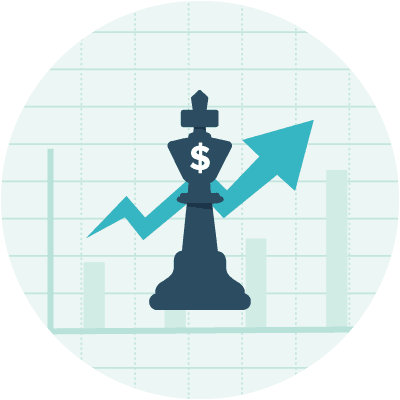What Is Market Cap?
REtipster does not provide tax, investment, or financial advice. Always seek the help of a licensed financial professional before taking action.
Shortcuts
- Market cap shows the total value of a company’s shares; in other words, it tells you how much money you’d need to buy all of the company’s stock.
- You calculate it by multiplying the total number of shares by the current price of one share.
- Investors use market cap to compare the size and value of a company to others in the same industry.
- Market cap is important for investors because it helps find stocks offering big returns or stable dividends.
- It’s not good to rely only on market caps to choose investments since stock prices can be manipulated and some stocks are naturally undervalued (or overvalued).
Why Is Market Cap Important?
Market cap is important because it tells which investments can offer big returns quickly or pay high dividends consistently in the long run.
Investors and analysts use market cap to measure a company’s size and value compared to others in the same industry. Usually, companies with higher market caps are seen as more established and stable, while those with lower market caps are smaller and riskier.
Big-cap companies have strong brand recognition and reputation. They are less likely to vanish and their prices don’t change wildly, which can keep the value of your investments safe.
On the other hand, mid-cap stocks may not always match the success of large-cap stocks, but they may provide a balance between growth potential and risk.
Meanwhile, Small-cap companies can vary in nature; they may be newer companies, operate within niche industries, or established businesses with smaller market capitalizations. They have a lot of growth potential, so investing early could yield big returns.
However, they are very sensitive to business or economic downturns[1]. Their share prices can change quickly, making them risky for those who can’t handle big price changes.
Does Market Cap Indicate Company Performance?
Market cap can hint at a company’s performance, but it doesn’t show everything. Relying only on this number can mislead investors because some stocks are undervalued, while others may be overpriced.
The stock market can also be manipulated[2], despite regulators’ best efforts. Some people take advantage of inside knowledge about big events that can drive stock prices up or down. Some groups buy specific stocks when they are cheap, spread fake rumors to generate interest, then sell them when the prices are high.
Shorting is another example of potential market manipulation. This practice refers to when “whales” (big investors with enough shares to move the market) borrow shares and sell them with the intention to buy them back at a lower price.
When building an investment portfolio, it’s important to identify your goals. Some investors want to grow their wealth, while others want to preserve it. Furthermore, it’s usually unwise to buy stocks of companies you don’t understand.
In general, it’s crucial to understand the competitive advantages of businesses you know[3], learn about their fair stock prices, and choose ones with a good safety margin.
Market Cap as a Tool for Business Valuation
To find a company’s real market value, you can use metrics like return on equity (ROE)[4], price-to-sales (P/S) ratio[5], and price-to-earnings (P/E) ratio[6].
Put another way, market cap only shows the cost to buy all of a company’s shares, but not the actual worth of the company.
In theory, a company can have a high intrinsic valuation due to factors such as promising long-term growth potential and low corporate debt, despite having a small market cap.
High Market Cap Companies in a Recession
Companies with big market caps may be more resilient during a recession, though note that performance can be industry and company-specific.

Apple is the world’s biggest company in terms of market cap.
Mid- and small-cap stocks may struggle before or during a recession and can be more vulnerable to large sell-offs. Many factors can influence this, including the industry, the specific economic situation, and investor sentiment.
Big-cap stocks can also be vulnerable in a recession, though their brand recognition and established presence can potentially contribute to their stability.
Public companies in certain sectors, such as utilities or consumer staples, may continue to pay dividends during economic downturns, although this depends on the individual company’s financial health and policy[7].
However, small-cap stocks can often bounce back robustly after a recession. Historically, they have sometimes provided higher returns than large-cap stocks in the recovery period after a recession, although this can vary based on individual market cycles and specific economic circumstances[8]. So, it can be smart to have resources ready to invest in them when the recession ends.
Sources
- Rode, M. (2022, July 13.) Should Investors Take a Closer Look at Downtrodden Small-Cap Stocks? American Century Investments. Retrieved from https://www.americancentury.com/insights/should-investors-take-a-closer-look-at-downtrodden-small-cap-stocks/
- Cheprasov, A. (n.d.) Forms of Market Manipulation: Definitions & Examples. Study.com. Retrieved from https://study.com/academy/lesson/forms-of-market-manipulation-definitions-examples.html
- Levy, A. (2022, November 8.) How to Pick a Stock for the First Time. The Motley Fool. Retrieved from https://www.fool.com/investing/how-to-invest/stocks/how-to-pick-stocks/
- Return on Equity (ROE). (2023, February 1.) Corporate Finance Institute. Retrieved from https://corporatefinanceinstitute.com/resources/accounting/what-is-return-on-equity-roe/
- What is the Price-to-Sales (P/S) Ratio? (2021, March 13.) Robinhood. Retrieved from https://learn.robinhood.com/articles/01lnclx5jYAuQ0rCihxnlz/what-is-the-price-to-sales-p-s-ratio/
- Davis, C. & Taube, S. (2022, October 13.) How to Use PE Ratio in Your Investing Strategy. NerdWallet. Retrieved from https://www.nerdwallet.com/article/investing/pe-ratio-definition
- Brock, T. (2023, January 30.) What to Invest in During a Recession. Annuity.org. Retrieved from https://www.annuity.org/personal-finance/recession/what-to-invest-in-during-a-recession/
- When Recessions End, Small Caps Have Led the Way. (n.d.) The Prudential Financial. Retrieved from http://news.prudential.com/images/20026/Small%20Caps%20Lead%20the%20Way.pdf



